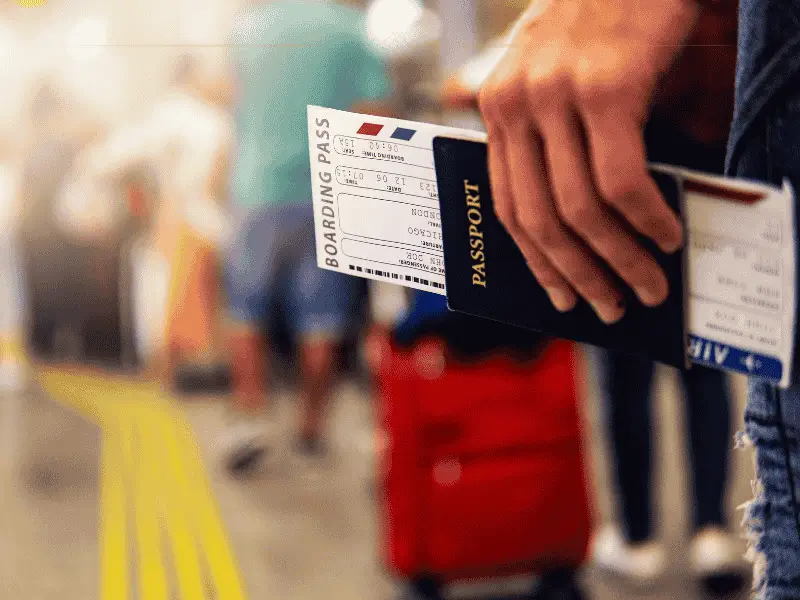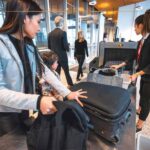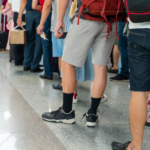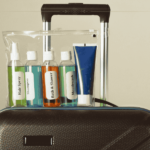For most travelers, the airport security process is a predictable choreography of lines, document checks, and the occasional awkward pat-down. But for an unlucky few, an inconspicuous four-letter code printed on their boarding pass transforms this routine into a significantly more intensive experience. This code—SSSS—signals to security personnel that you’ve been selected for special scrutiny, and it can dramatically affect your journey through the airport.

The Mysterious Four Letters
When passengers discover the letters SSSS on their boarding passes, they’re often unaware of the implications until they reach the security checkpoint. Standing for Secondary Security Screening Selection, this designation indicates that the traveler has been flagged for additional security measures beyond the standard procedures that most passengers experience.
The presence of these four letters isn’t immediately obvious to the untrained eye. They typically appear in a corner of the boarding pass, alongside other codes and information that most travelers ignore. However, security personnel are trained to spot this designation immediately, and its consequences become apparent the moment you approach the checkpoint.
Origins of Enhanced Screening
The SSSS system was implemented by the Transportation Security Administration (TSA), which operates under the United States Department of Homeland Security. Following the attacks of September 11, 2001, the American government overhauled its approach to transportation security, introducing numerous measures designed to prevent future attacks.
The TSA’s mandate centers on protecting transportation networks while allowing for the free movement of people and commerce. This delicate balance between security and convenience has led to the development of various screening protocols, with SSSS representing one of the most intensive.
While the system primarily affects flights entering or operating within the United States, its influence extends globally due to American aviation regulations that apply to any carrier serving U.S. destinations.
The Selection Process
The exact criteria that lead to an SSSS designation remain deliberately obscure. The TSA maintains a policy of secrecy regarding its selection methods to prevent individuals from circumventing the system. However, aviation experts and frequent travelers have identified several patterns that appear to increase the likelihood of selection.
Last-minute bookings often trigger additional scrutiny, as security agencies view spontaneous travel as potentially suspicious. One-way tickets similarly raise concerns, particularly on international routes. Travel to or from countries deemed high-risk for terrorism can also result in an SSSS designation, as can unusual itineraries or travel patterns.
Some travelers report receiving the designation seemingly at random, suggesting that an element of unpredictability may be built into the system to prevent individuals from identifying and exploiting patterns in the selection process.
The Enhanced Screening Experience
For travelers designated with SSSS, the security experience differs substantially from the standard procedure. Upon presenting their boarding pass at the security checkpoint, they are directed to a separate area for enhanced screening.
This process typically begins with a thorough document check, where security personnel verify the traveler’s identification against their boarding pass multiple times. Physical screening follows, including a comprehensive body scan using advanced imaging technology and a manual pat-down by a security officer. This physical examination is notably more thorough than the occasional pat-downs that regular travelers might experience.
Luggage inspection for SSSS-designated travelers is particularly intensive. Security officers manually examine every item in both carry-on and checked baggage, often using specialized equipment to detect trace amounts of prohibited substances. Electronic devices receive special attention, with travelers frequently asked to power on laptops, tablets, and phones to demonstrate that they function normally and haven’t been modified.
Security personnel may also use chemical detection swabs on various surfaces, including shoes, clothing, luggage handles, and electronics. These swabs detect minute traces of substances associated with explosives or other prohibited materials.
Time Implications
Perhaps the most significant impact of an SSSS designation is the additional time required for security processing. While standard security screening might take 15-30 minutes during normal periods, enhanced screening can extend this to an hour or more, even when airport traffic is light.
This time requirement creates practical challenges for travelers. Airlines typically advise passengers to arrive at the airport two hours before domestic flights and three hours before international departures. For those selected for enhanced screening, these margins may prove insufficient.
In numerous documented cases, travelers have missed their flights due to extended security procedures, leading to complex rebooking situations and, in some cases, unexpected overnight stays. This disruption can cascade through complex itineraries, affecting connections and subsequent travel arrangements.
Psychological Impact
Beyond the practical implications, the SSSS designation carries psychological consequences for travelers. Being singled out publicly for enhanced scrutiny can create feelings of embarrassment or anxiety, particularly when fellow passengers observe the process.
The invasive nature of the screening itself—including physical contact during pat-downs and the comprehensive examination of personal belongings—can feel violating to some travelers. For individuals with past traumatic experiences or certain medical conditions, these procedures may prove especially distressing.
Additionally, the uncertainty surrounding the selection process can create a sense of helplessness and frustration. Travelers may wonder why they were chosen and whether they’ll face similar scrutiny on future journeys, creating anxiety about subsequent travel plans.
Patterns of Selection
While the TSA maintains that SSSS designation occurs without discriminatory intent, patterns observed by frequent travelers suggest certain demographics may face selection more frequently than others.
Travelers of Middle Eastern or South Asian descent have reported receiving the designation disproportionately, raising concerns about racial and religious profiling within the system. Male travelers appear to receive the designation more frequently than female passengers, and younger adults seem more likely to be selected than elderly travelers.
These patterns have raised questions about the algorithmic fairness of the selection process and whether implicit biases may be encoded in the system’s parameters. However, without transparency regarding the selection criteria, these concerns remain difficult to address definitively.
Seeking Redress
For travelers who regularly receive the SSSS designation, the Department of Homeland Security offers a potential solution through its Traveler Redress Inquiry Program (TRIP). This program allows individuals who believe they have been incorrectly or unfairly selected for enhanced screening to file for a redress number.
The application process requires detailed personal information and travel history. If approved, the traveler receives a redress number that can be entered when booking future flights, potentially reducing the likelihood of receiving an SSSS designation.
However, the effectiveness of this program remains questionable. The DHS explicitly states that redress numbers do not guarantee exemption from enhanced screening, and many travelers report continuing to receive the designation even after obtaining a redress number.
The application review process can take weeks or months, and the criteria for approval remain opaque. Some travelers report quick resolution, receiving their redress number within days, while others wait months without response.
International Variations
While the SSSS system is specific to American aviation security, similar enhanced screening protocols exist in various forms worldwide. The European Union employs comparable measures under different designations, as do aviation authorities in Australia, Canada, and numerous Asian countries.
These international systems often share information and methodologies, creating a global network of enhanced screening protocols. For frequent international travelers, this means potentially facing different versions of enhanced screening depending on their destination and routing.
Some countries maintain bilateral security agreements that streamline the process for certain travelers. For example, trusted traveler programs like Global Entry in the United States and similar initiatives in partner countries can reduce the likelihood of enhanced screening for pre-approved individuals who have undergone background checks.
Technological Evolution
The implementation of enhanced screening has evolved significantly since its inception. Early versions relied heavily on manual inspection and basic scanning technology, while contemporary systems incorporate advanced imaging, artificial intelligence analysis, and biometric verification.
This technological progression has altered the enhanced screening experience. Modern body scanners produce detailed images that identify potential threats without physical contact, reducing the need for invasive pat-downs. Advanced explosive detection systems can identify trace amounts of prohibited substances within seconds, accelerating the screening process.
Facial recognition technology increasingly supplements document verification, allowing security personnel to confirm identities against database records instantly. Behavioral analysis software monitors movement patterns and micro-expressions to identify potential security concerns based on non-verbal cues.
These technological advancements have both benefits and drawbacks for travelers. While they potentially reduce screening time and physical invasiveness, they raise new concerns about privacy and data security. The collection and storage of biometric information and travel patterns create databases that could potentially be vulnerable to misuse or breach.
Preparing for Enhanced Screening
For travelers who discover the SSSS designation on their boarding pass, preparation can significantly improve the experience. Arriving at the airport with substantial additional time—at least one hour beyond the standard recommendation—provides a buffer against potential delays.
Organizing luggage for efficient inspection helps streamline the process. Keeping electronics easily accessible, minimizing the number of small items that could require individual examination, and ensuring all liquids comply with aviation regulations can reduce screening time.
Maintaining calm and cooperative behavior throughout the process typically leads to the most efficient resolution. Security personnel have significant discretion regarding the thoroughness of their inspection, and a confrontational approach may result in more intensive scrutiny.
Understanding one’s rights during the screening process provides important protection. While enhanced screening is mandatory for boarding, travelers maintain certain rights regarding privacy during physical searches, the handling of medical devices or medications, and accommodation for disabilities or health conditions.
The aviation security landscape continues to evolve in response to emerging threats and technological capabilities. The SSSS system and similar enhanced screening protocols will likely undergo significant transformation in coming years as authorities balance security imperatives with efficiency and passenger experience concerns.
Artificial intelligence promises to refine the selection process, potentially reducing false positives while more accurately identifying genuine security risks. Biometric identification systems may eventually replace document-based verification entirely, streamlining the process for previously vetted travelers.
Risk-based security approaches—where screening intensity varies based on assessed threat levels—continue to gain traction globally. These systems aim to focus resources on higher-risk individuals while expediting processes for lower-risk travelers.
Privacy advocates and civil liberties organizations maintain pressure for greater transparency and accountability in security protocols. This advocacy may eventually lead to more explicit criteria for enhanced screening selection and clearer redress processes for those who believe they have been unfairly targeted.
As aviation security continues to adapt to changing circumstances, the unexpected appearance of four letters on a boarding pass will remain a significant moment in the travel experience for those selected—a reminder of the complex balance between security imperatives and the freedom of movement that defines modern air travel.




